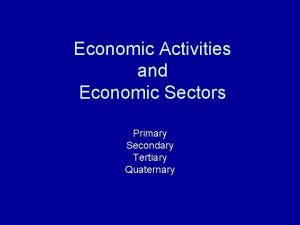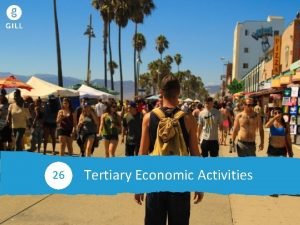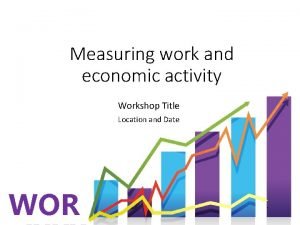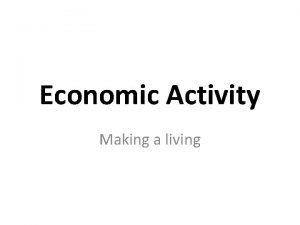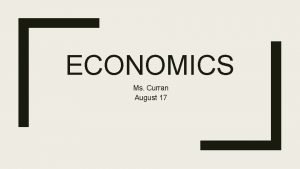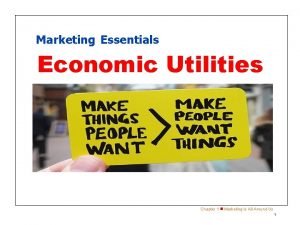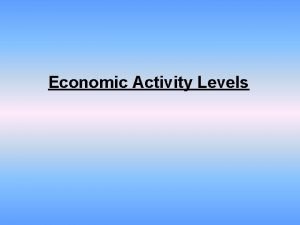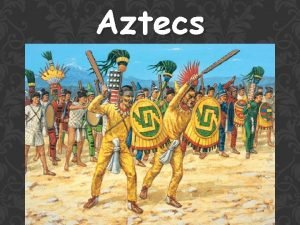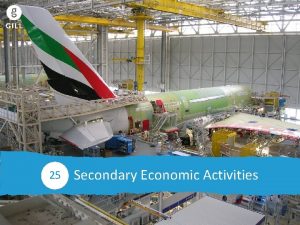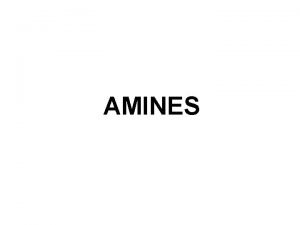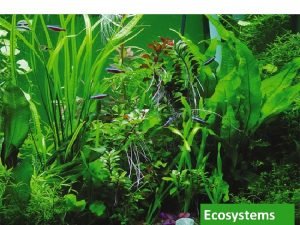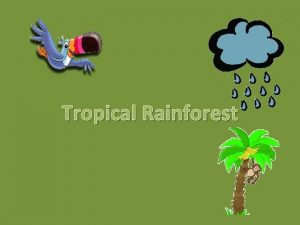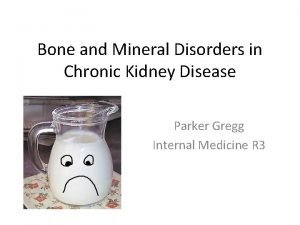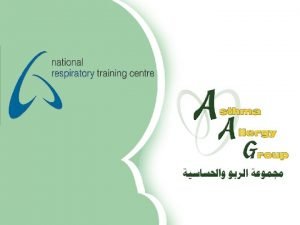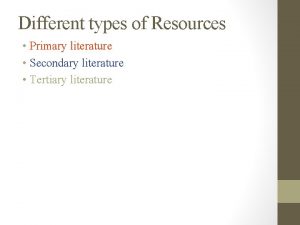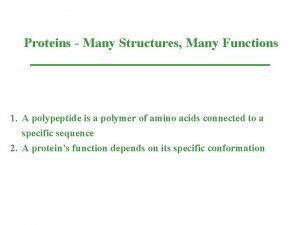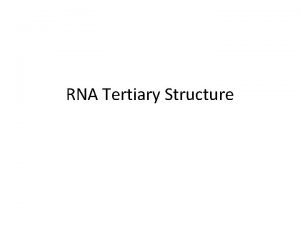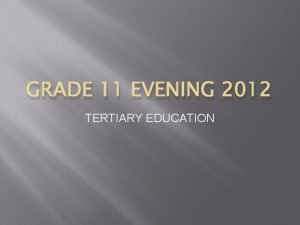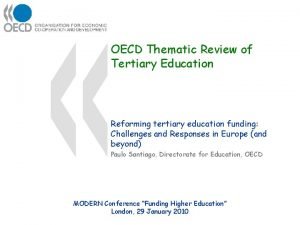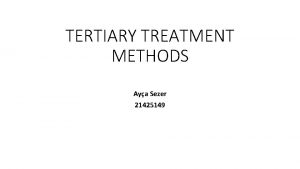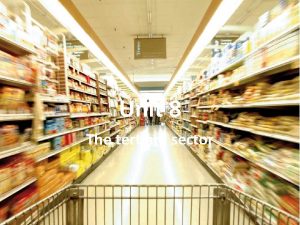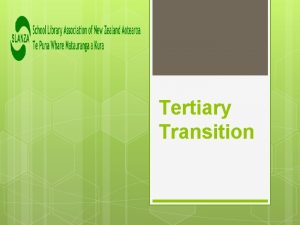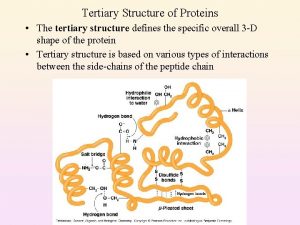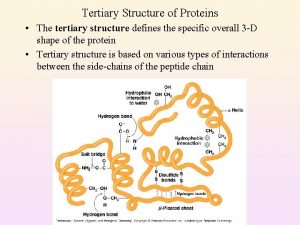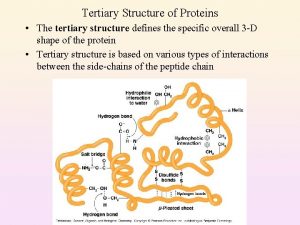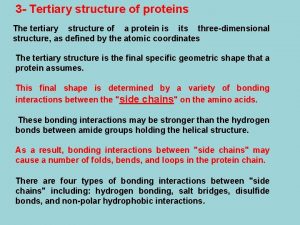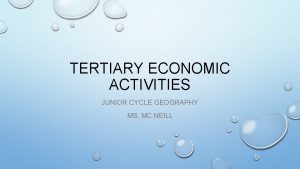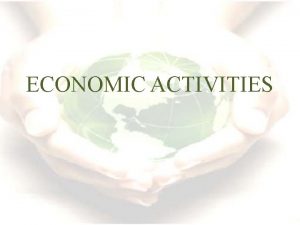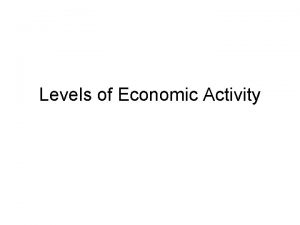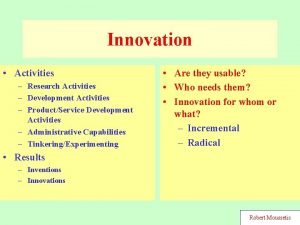Tertiary Economic Activities 26 26 0 Tertiary Economic


























- Slides: 26

Tertiary Economic Activities 26

26. 0 Tertiary Economic Activities Learning Intentions You will be able to: § Explain the term ‘tertiary economic activities’. § Explain what tourism is and understand what is meant by sustainable tourism. § Discuss the connection between tourism and the physical landscape, and tourism and transport. 26

26. 1 What are Tertiary Economic Activities? Tertiary Economic Activities Tertiary economic activities provide services that are very useful to communities and people. They are also known as the service sector. Employment by economic sector in Ireland (2017) 26

26. 2 Tourism, the Physical Landscape and Transport Tertiary Economic Activities Tourism is a tertiary economic activity. Its services include entertainment and cultural exchange. Tourists are people who travel for leisure outside their local area. The physical landscape stimulates tourism. Tourists 26

13. 2 Forecasting the Weather Case Study: The Alps Tertiary Economic Activities The Alps are a mountain system located in south-central Europe. They extend for almost 1, 200 km, stretching across seven European countries. 26

13. 2 Forecasting the Weather Case Study: The Alps Tourism in the Alps About 60– 80 million tourists travel to the Alps each year. There are over 600 ski resorts in the Alps, providing over 85% of Europe’s skiing landscape. The Alps are a ‘snow-sure destination’. The Alps provide a wide variety of slopes. Tertiary Economic Activities 26

13. 2 Forecasting the Weather Case Study: The Alps and Transport The physical landscape of the Alps can present a difficulty when it comes to travelling to and from the region. The cold winter temperatures and heavy snowfalls can make travel conditions dangerous. Tourists can travel to the Alps by air or rail. Tertiary Economic Activities 26

13. 2 Forecasting the Weather Case Study: The Alps Tertiary Economic Activities 26 How Alpine Tourism Affects the Physical Landscape Road networks are being constructed and improved in the region to allow for better access. This can destroy the natural slopes of the mountains. Creating these ski slopes has also increased the rate at which erosion is occurring in the Alps. Air pollution is also impacting the physical world of Alpine regions. Fossil fuels used in transport release emissions. Impure air from these emissions can be trapped at the bottom of the U-shaped valleys, where wind force is weaker.

13. 2 Forecasting the Weather Case Study: The Mediterranean Tertiary Economic Activities The Mediterranean region has long been one of the top tourism destinations in the world, with over 320 million tourists visiting the region in 2016 alone. 26

13. 2 Forecasting the Weather Case Study: The Mediterranean Climate and Tourism Summer § average temperature of 22 degrees Celsius § sunshine can last anywhere between 7– 11 hours per day Winter § average 6– 10 hours of daily sunshine § temperatures are usually between 2– 10 degrees Celsius Tertiary Economic Activities 26

13. 2 Forecasting the Weather Case Study: The Mediterranean Tertiary Economic Activities 26 How Mediterranean Tourism Affects Transport The Mediterranean tourism year can be divided into three seasons: peak season (mid-June through August) mid-season (April through mid-June and September through October) off-season (November through March) The Mediterranean is well serviced by air, sea and road routes. However, high demand at peak times creates an increased need for transport routes.

13. 2 Forecasting the Weather Case Study: The Mediterranean Tertiary Economic Activities 26 Airports servicing the Med

13. 2 Forecasting the Weather Case Study: The Mediterranean How Mediterranean Tourism Affects the Physical Landscape Construction related to tourism development has the greatest negative environmental impact on Mediterranean towns and cities. Negative impacts include: Hastily built high-rise developments, which detract from the natural beauty of the area Roads and hotels which consume beach space, leaving hardly any for tourists to enjoy Tertiary Economic Activities 26

26. 3 Tourism in Ireland Tertiary Economic Activities 26 In 2016, over eight million international visitors came to Ireland, a record number. Domestic tourism also reached a record high, with over two million Irish people holidaying in Ireland in 2016. Hiking in Donegal

Tertiary Economic Activities 26 13. 2 Forecasting the Weather Case Study: Tourism and Ireland’s Physical Landscape Ireland relies on its unspoilt physical landscape and stunning natural features, and not its climate, to attract tourists. The inclusion of Ireland in international films and television programmes has helped market Ireland to the world and attract more tourists to these shores.

Tertiary Economic Activities 26 13. 2 Forecasting the Weather Case Study: Tourism and Ireland’s Physical Landscape Skellig Michael is a towering sea crag rising from the Atlantic Ocean, nearly 12 km west off the Kerry coast. Star Wars: The Force Awakens (2015) and Star Wars: The Last Jedi (2017) featured scenes filmed on Skellig Michael. Boat trips to and from the island have become extremely popular.

Tertiary Economic Activities 26 13. 2 Forecasting the Weather Case Study: Tourism and Ireland’s Physical Landscape The Cliffs of Moher In 2009, the Cliffs of Moher were included in scenes from Harry Potter and the Half. Blood Prince. The cliffs are one of Ireland’s most popular tourism destinations.

Tertiary Economic Activities 26 13. 2 Forecasting the Weather Case Study: Tourism and Ireland’s Physical Landscape Northern Ireland Game of Thrones has filmed many scenes around Northern Ireland. Tollymore Forest Park, Co. Down, and the Shillanavogy Valley, Co. Antrim, have been used as landscapes or backdrops for many of the show’s scenes. Tourists can now take guided tours through these areas.

Tertiary Economic Activities 26 13. 2 Forecasting the Weather Case Study: Tourism and Ireland’s Physical Landscape The Wild Atlantic Way is Ireland’s first longdistance touring route, stretching along the Atlantic coast from Donegal to West Cork. It is 2, 500 km in length. Numerous paths and trails provide excellent hiking and cycling routes.

Tertiary Economic Activities 26 13. 2 Forecasting the Weather Case Study: Tourism and Ireland’s Physical Landscape Ireland’s Airports and Ports International tourists arrive in Ireland by air or sea. Ireland has five international airports. Tourists can reach Ireland by sea through four ports.

Tertiary Economic Activities 26 13. 2 Forecasting the Weather Case Study: Tourism and Ireland’s Physical Landscape How Irish Tourism Affects Transport Airports will provide more flights during their busy ‘peak’ periods. Airlines are always concerned about the costs of running flights during off-seasons. Airlines may decide to cancel flights or reduce the number flights during off-seasons. Irish Ferries provide their service in a similar fashion. They offer more trips to and from Dublin during their busy period

Tertiary Economic Activities 26 13. 2 Forecasting the Weather Case Study: Tourism and Ireland’s Physical Landscape Ireland’s Road Network Motorways – the quickest and most direct route through the physical landscape. National primary roads – dual carriageways or main roads connecting towns and cities. National secondary roads – narrower roads that do not bypass towns and villages. Regional roads – narrower local roads.

Tertiary Economic Activities 26 13. 2 Forecasting the Weather Case Study: Tourism and Ireland’s Physical Landscape How Tourism Affects the Physical Landscape of Ireland Fa ilte Ireland has acknowledged that Ireland’s unique landscape and physical beauty is the main attraction for tourists coming to Ireland. The increased numbers of tourists visiting Ireland has the potential to damage this natural beauty in the following ways: Rising greenhouse gas emissions from increased traffic can damage landscapes. Litter results from increased numbers of visitors to our rural/coastal areas and unique landscapes. Visitors engaging in activities such as hiking and hillwalking have the potential to harm sensitive areas of high ecological and resource value.

26. 4 Sustainable Tourism Tertiary Economic Activities ‘Take only photographs and leave only footprints’ This is the slogan for sustainable tourism. Sustainable tourism provides both employment and a source of income without damaging the natural environment. 26

26. 4 Sustainable Tourism The Alps Developing ecofriendlier travel packages to reduce carbon footprint Reducing the number of new ski slopes created each year Tertiary Economic Activities The Mediterranean Measuring and monitoring the environmental impacts of tourism activities on the landscape Identifying, protecting and restoring vulnerable and damaged coastal landscapes Reducing the number of high-rise hotels built directly on coastlines 26 Ireland Promoting the ‘Tidy Towns’ competition, encouraging locals to maintain towns and villages throughout the country Encouraging travel by rail, bus and bike, and opening up walking routes around Ireland, in an effort to reduce carbon footprint

Tertiary Economic Activities Video: Game of Thrones Influence on Irish Tourism 26
 Primary activities definition
Primary activities definition Tourism in the paris basin
Tourism in the paris basin Economic sectors
Economic sectors Tertiary
Tertiary Types of tertiary activities
Types of tertiary activities Indoor activities
Indoor activities Support activities and primary activities
Support activities and primary activities Operating activities vs investing activities
Operating activities vs investing activities Economic activities by men and women
Economic activities by men and women Economic activities
Economic activities Economics
Economics Form utilities
Form utilities Level of economic activity
Level of economic activity Secondary economic activities in the west of ireland
Secondary economic activities in the west of ireland The religion of the aztecs
The religion of the aztecs Footloose industry
Footloose industry Chapter 1 lesson 2 our economic choices worksheet answers
Chapter 1 lesson 2 our economic choices worksheet answers Economic growth vs economic development
Economic growth vs economic development What is economic growth and development
What is economic growth and development Primary amine
Primary amine Tertiary consumer
Tertiary consumer Tropical rainforest trophic levels
Tropical rainforest trophic levels Phosrenal
Phosrenal Levels of prevention of diabetes mellitus
Levels of prevention of diabetes mellitus Tertiary literature
Tertiary literature Protein tertiary structure bonds
Protein tertiary structure bonds Health education activities
Health education activities


